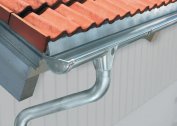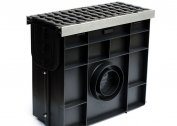A clogged sewer pipe at home is not uncommon. This happens both in the bathroom and in the kitchen. In the first case, the cause may be hair stuck in the drain and some cleaning products. A large amount of edible fat and small food debris get into the kitchen sink, which are collected like plaque on the inside of the pipes and clog them. You can get rid of such problems on your own. There are many effective ways to do this, which will be described later.
Hot water and boiling water
 This is the easiest way to remove greasy deposits in the pipes, which caused blockage. It does not require any additional funds, except boiling water. Hot water easily removes fat. But for the effectiveness of this method, two conditions must be met:
This is the easiest way to remove greasy deposits in the pipes, which caused blockage. It does not require any additional funds, except boiling water. Hot water easily removes fat. But for the effectiveness of this method, two conditions must be met:
- The blockage must be fresh.
- Exposure to water should be long enough.
The second condition creates the main minus of this method. If hot water appears in your house thanks to a boiler, then most likely you will have to spend most of its contents to eliminate the blockage, which may not always be acceptable.
This method has another nuance. Before proceeding with it, check where exactly the blockage is located. If the water decreases, but very slowly, then the blockage is at a distance of about 1 meter from the siphon. In this case, the use of hot water will be quite appropriate. If the water from the sink does not go away at all or gets stuck at a certain mark, then do not break the resulting cork with boiling water.
Step-by-step instruction:
- Open the faucet with hot water, and draw a full sink of boiling water.
- Wait until the water is completely gone, and repeat the procedure.
- Fill the sink with hot water until it leaves freely, without any obstruction.
Soda and Vinegar
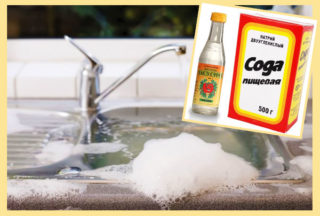 Soda and vinegar, when reacting, create strong pressure, which quickly breaks through the cork that has formed in the pipe. Due to this property of soda and vinegar, recipes with these components can be used to remove more serious and old blockages.
Soda and vinegar, when reacting, create strong pressure, which quickly breaks through the cork that has formed in the pipe. Due to this property of soda and vinegar, recipes with these components can be used to remove more serious and old blockages.
Please note that upon entering into the reaction, soda and vinegar emit caustic substances, which a person may very well poison. Therefore, always keep at the ready what you can tightly plug the drain when using such recipes.
Recipe number 1
You will need:
- Half a pack of soda.
- 100 ml vinegar.
- 2 liters of hot water.
Pour soda into the pipe, then carefully add vinegar. As soon as the reaction begins, cover the drain with a rag or a lid. As you already know, this is necessary to protect the room from harmful substances released by the combination of soda and vinegar. After 20-30 minutes, open the drain and spill it with hot water.
Recipe number 2
You will need:
- 100 gr. soda.
- 100 ml vinegar.
- 2 liters of hot water.
Carefully mix vinegar and soda in a glass or clay dish, and then send the resulting mixture to the drain. Then close the drain with a rag or a lid. After 1.5-2 hours, pour boiling water over the pipe.
Salt and soda
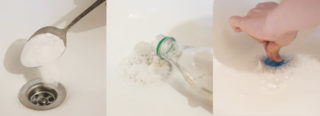 Salt in combination with soda also give a positive effect, since they dissolve fat perfectly. Such recipes are suitable for eliminating small blockages. Please note that for such recipes it is worth using only coarse salt.
Salt in combination with soda also give a positive effect, since they dissolve fat perfectly. Such recipes are suitable for eliminating small blockages. Please note that for such recipes it is worth using only coarse salt.
Recipe number 1
You will need:
- 350 gr coarse salt;
- 200 gr. soda;
- 300 ml hot water.
Pour salt into the drain, then soda, pour boiling water over everything and leave for 20 minutes. Then spill the pipe with hot water. If the blockage does not go away, repeat the procedure.
Recipe number 2
If vinegar is added to soda and salt, then the effect of the product will increase several times.
You will need:
- 200 gr. salts;
- 200 gr. soda;
- 10 ml vinegar
- 2 liters of hot water.
Pour loose components into the pipe and fill everything with vinegar. When the reaction begins, cover the pipe with a rag. After 1 hour, spill the drain with hot water.
Will specialized household chemicals help?
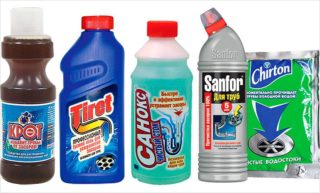 It’s definitely not worth using dishwashing detergents such as Fairies or Myth to clean pipes, as some of them contain surfactants that also contribute to clogging of sewer pipes. Therefore, to remove blockages, it is worth using specialized tools that you can buy in a regular household chemistry store.
It’s definitely not worth using dishwashing detergents such as Fairies or Myth to clean pipes, as some of them contain surfactants that also contribute to clogging of sewer pipes. Therefore, to remove blockages, it is worth using specialized tools that you can buy in a regular household chemistry store.
Mr. Muscle
This tool is inexpensive and copes with problems. In addition to removing blockages, Mr. Muscle also disinfects the surface of the pipe. Using this tool is quite simple:
- Pour the contents of the bag into the tube.
- Gently pour 250 ml of powder. warm water.
- After half an hour, rinse the sink or bathtub thoroughly.
One bag is enough for you to completely eliminate pipe problems.
Mole
A remedy from a domestic manufacturer, which costs no more than 80 rubles, can be very effective. Its only minus: at least 2 hours must pass for the remedy to work.
How to use "Mole":
- Pour 200-250 ml. contents of the bottle in the drain;
- Leave the product for 2 hours;
- After that, rinse the pipe thoroughly with a powerful pressure of water.
If necessary, use Mole repeatedly.
Pothan
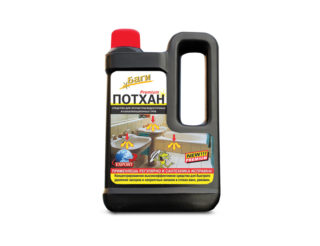 The advantage of this tool is that it can be used in any pipes, plastic and cast iron. In addition, the duration of "Potkhan" does not exceed 5 minutes, which is quite convenient for those who do not have the desire and the ability to wait a long time for the result. Using it is pretty easy:
The advantage of this tool is that it can be used in any pipes, plastic and cast iron. In addition, the duration of "Potkhan" does not exceed 5 minutes, which is quite convenient for those who do not have the desire and the ability to wait a long time for the result. Using it is pretty easy:
- Pour 100 ml into the tube. funds and 150 ml. boiling water;
- After 5 minutes, rinse the drain with hot water.
Flup
This tool is quite effective even for severe blockages. It also removes hair stuck in the drain of the bath. But its effectiveness is offset by causticity, so wear protective gloves, an apron and glasses before starting the procedure.
How to use:
- Pour 300-400 ml. funds in the drain;
- Add 500 ml. hot water;
- After 5 minutes, rinse thoroughly with cold water.
For different types of blockages, there may be a different dosage of water and “Floop”, so carefully read the instructions on the packaging of the product before use.
How to prevent further clogging
To prevent clogging, you must regularly take care of the cleanliness of the sewer pipes. To do this, it is enough to rinse them once or twice a week with plenty of boiling water. You can simply leave the hot water tap open for 30-60 minutes. Boiling water itself will clean the inside of the pipes, removing residual grease and surfactants from it from cleaning products.
In order to protect the pipe in the kitchen from blockages, it is worthwhile to carefully monitor what gets into the sink with dirty plates. Never leave leftovers on food in dirty dishes, otherwise they will quickly arrange a greasy cork in your drain or simply clog the siphon, which you will then have to disassemble, and this is not so easy to do.
Even better, if after each dishwashing you will briefly leave the faucet with hot water open. Or, you can spill the drain with boiling water from the kettle, if you have a boiler and you save hot water.
A clogged pipe is always uncomfortable. Especially if this happens in the midst of cooking or washing dishes. Do not delay the elimination of blockage, especially since it is quite simple to do. And even better, try to take care in advance of the purity of the siphon and drain, so as not to resort to various means of cleaning them.
